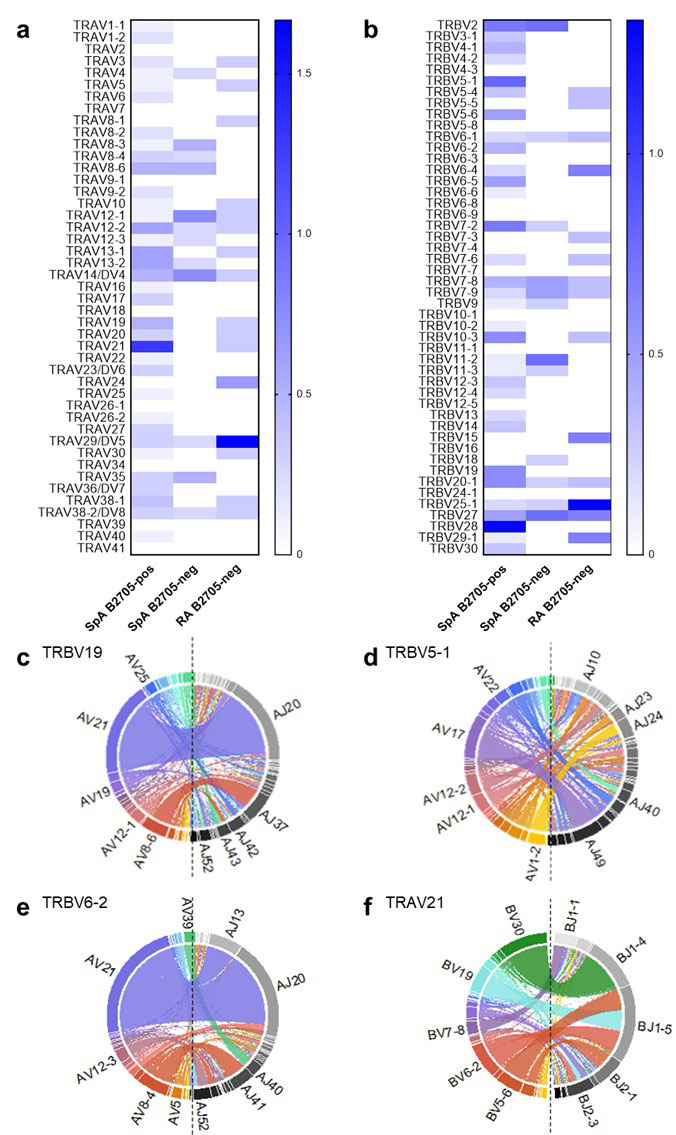Session Information
Session Type: Poster Session C
Session Time: 1:00PM-3:00PM
Background/Purpose: Spondyloarthritis (SpA) is strongly associated with HLA-B27. The arthritogenic antigen hypothesis assumes the existence of specific peptides presented by risk-conferring HLA-B27 alleles to antigen-specific CD8+ T cells, which then initiate or sustain autoimmune reactions. Studies analyzing T cell receptor (TCR) repertoire found preferred Variable TCR chains and motifs in the hypervariable complementary determining region (CDR) 3, but analyzed only TCR β-chains in bulk analyses (Komech et al., Rheumatology 2018; Hanson et al., A&R 2020).
Therefore, the objective was to analyze full sequence information of TCR including matching α- and β-chains from single CD8+ T cells and characterize the transcriptomes of expanded and non-expanded clonotypes in synovial fluid (SF) of SpA patients.
Methods: We included 17 patients with active gonarthritis: 10 patients with HLA-B27 positive (B27pos) SpA, 4 HLA-B27 negative (B27neg) SpA and 3 rheumatoid arthritis (RA). Antigen-experienced CD8+ T cells were sorted out of SF by flow cytometry. Single cell sequencing was performed to analyze matching TCR α- and β-chains. For 7 patients (3 B27pos SpA, 2 B27neg SpA, 2 RA), additionally whole transcriptome analyses were performed.
Results: We found strong biases when analyzing α and β chains of TCR Variable regions and CDR1 and CDR2 sequences (Figure a,b): AV21, AV12-2, and AV17 were highly enriched in B27pos SpA as compared to B27neg subjects. Amongst the highest expressed clones, we could confirm enrichment for previously described TRBV genes as BV19, BV5-1 and BV6-2. We examined TCR α/β combinations and focused on those detected in at least three different B27pos SpA but not in any of the B27neg patients (Figure c-f). The combinations TRBV19/TRAV21 and TRBV6-2/TRAV21 were most likely specific for B27pos SpA and might reflect interaction of these TCR chains with HLA-B27.
Sequences of CDR3 loops, which predominantly interact with HLA-bound antigenic peptides, revealed striking common structural motifs in α- and β-chains. Focusing on the most prominent TRAV21 chains pairing with TRBV19, 5-1 and 6-2 chains, revealed identical sequences in different patients and common structural motifs in other patients.
Gene expression levels provided evidence that expanded cell populations had tissue resident memory (TRM) phenotypes (elevated expression of activation, migration and tissue retention markers, downregulated genes characteristic for T cell egress), while this phenotype was not very pronounced in non-expanded cells. Furthermore, markers for T cell exhaustion and apoptosis were elevated in expanded cells of B27pos SpA patients.
Conclusion: Analysis of single antigen experienced CD8+ T cells of B27pos SpA patients revealed significant clonal expansions and common motifs in the CDR loops. Two of the four CDR1 and CDR2 loops were highly homologous suggesting that these loops interact with α-helices of HLA-B27. Common motifs in CDR3 loops of expanded clonotypes suggest recognition of a limited set of antigenic peptides presented by HLA-B27. Many of the expanded clonotypes showed a TRM phenotype, were exhausted and on the way to become apoptotic, which points toward a sustained contact to specific antigens.
To cite this abstract in AMA style:
Rademacher J, Deschler K, Lacher S, Huth A, Utzt M, Krebs S, Blum H, Beltrán E, Dornmair K, Poddubnyy D. Expanded CD8+ T Cell Clones from HLA-B*27-positive Patients with Spondyloarthritis Show Signs of Antigen-experience [abstract]. Arthritis Rheumatol. 2022; 74 (suppl 9). https://acrabstracts.org/abstract/expanded-cd8-t-cell-clones-from-hla-b27-positive-patients-with-spondyloarthritis-show-signs-of-antigen-experience/. Accessed .« Back to ACR Convergence 2022
ACR Meeting Abstracts - https://acrabstracts.org/abstract/expanded-cd8-t-cell-clones-from-hla-b27-positive-patients-with-spondyloarthritis-show-signs-of-antigen-experience/

